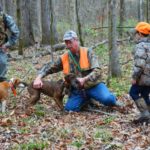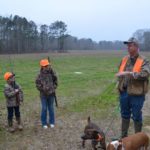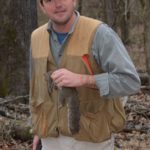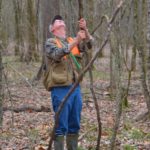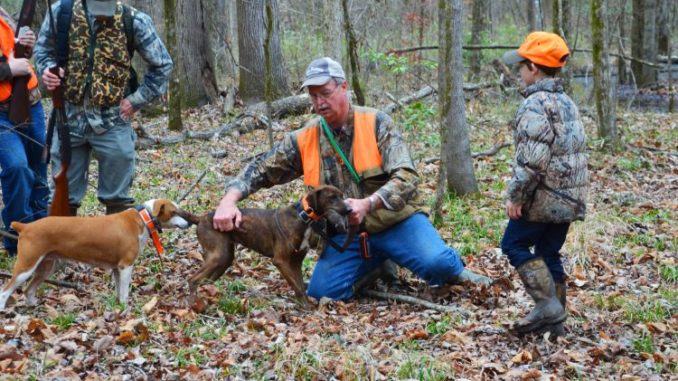
Hunting with dogs is a great way to bag a winter limit of squirrels — and also introduce youngsters to the sport.
Everything was gray.
The woods were drab, leafless and gray. The bare tree trunks and limbs were gray. The dead leaves underfoot were gray. And the sky was heavily overcast with uniformly gray clouds.
Even the squirrels were gray.
So conditions were perfect for a day of squirrel hunting with dogs, a sociable sport.
For most of the season, squirrel hunters are the most-reclusive of all outdoorsmen. They try to make themselves utterly invisible and silent in the woods. Crossing paths with another hunter ruins their morning.
But something magical happens in January, when all the leaves are off the trees — especially after deer season closes. The sounds of laughter, joking, dogs barking and shotguns banging ring through the woods as the time comes for squirrel hunting with dogs.
This was what Cameron Harris, 34, a lanky, square-jawed 6-foot-5 giant from Ferriday, called, “a big annual family hunt.” Harris’ father, Weldon, 64, and brother ,Taylor, 31, both cotton farmers from Kosciusko, Miss., were there.
The team’s dean was retired county agent Don Schmidt, 68, from Carthage, Miss. Family friend Shannon McMullin, 34, an oil-rig tool pusher, supplied the kids necessary for a fun hunt: Hunter, 14, Lilly, 10, and Parker, 8.
Most important to the success of the hunt were the two dog men: Joe Shumaker, 57, and Terry Fletcher, 60. Each brought two mountain cur squirrel dogs. Neither carried a gun.
“It’s not about the shooting for us,” Shumaker said. “We will carry a gun early in the season or when it’s just the two of us. We like to let the others shoot late in the season.”
Between 300 and 400 squirrels are killed over their dogs every year.
The final count was 10 people in the woods, not counting me, and it wasn’t a person too many. It takes a lot of eyes to spot a hidden squirrel — and a lot of shots to bring down one zig-zagging wide open through the trees.
Action starts early…
Thirty seconds after Fletcher and Shumaker unleashed their dogs, the curs barked, signaling they had treed their first squirrel.
The hunters, necks craned upwards, spread into a ring around the tree, working to get the youngsters a shot at the first squirrel. Parker McMullen just couldn’t spot the squirrel sitting in an open crotch in the tree. But Hunter’s double-barrel boomed and the squirrel tumbled down the trunk, obviously crippled.
Somehow, the spunky rodent scrambled between the legs of the four dogs intent on grabbing it, scampered up a tiny sweet gum tree and shot into a 2-inch hole.
Gone!
Fifteen minutes later, the dogs treed again.
“He’s in that tree over there,” Shumaker announced, pointing at a tree off to the side of the one where the dogs were barking. Squirrels often leave the trees that they run up to hide in another they deem more hospitable.
Of course, the dogs stick to the tree the squirrel climbed.
Taylor Harris’ shotgun boomed, and this one went into the bag.
… And often …
The next squirrel quickly ducked into a hollow gum, and the men moved on. Fifteen minutes later, the dogs put a squirrel up a tall oak tree where it sat in the bald open in the treetop. Taylor cracked down on him.
As it was falling, he yelled, “I see another one.”
Bam!
As it was falling, another hunter yelled, “He’s still alive.”
Kaboom!
“Not now,” Taylor popped off.
Two more squirrels, just like that.
“Let me shake a vine,” Shumaker said, grabbing a wrist-thick muscadine vine. One shake and another squirrel soared out of the tree like a flying squirrel. Three shots boomed at the squirrel that was scrambling 50 yards to a hollow tree. All three missed.
This was squirrel hunting with a dog at its best.
A few came easy — one shot at a sitting target, and the squirrel was in the bag.
Most came hard — a shake of the vine, and it was off to the races, 10 shots at a zig-zagging squirrel running wide open through the treetops, with no one cutting a hair until the ninth shot.
“That’s the fun in this,” Cameron Harris said.
This wasn’t a day for .22 rifles.
The pace was an on-and-off saunter through the woods, with occasional rest breaks that the senior hunters appreciated. It wasn’t strenuous, but by the hunt’s end, everybody knew they had walked a lot.
… Right to the end
By late morning, the eagle-eyed Shumaker, first to reach the treed dogs, shouted back to the gang, “There’s two coons up there.”
Shumaker and Fletcher tied the dogs to a small tree.
“They are already tuckered out,” Shumaker explained. “I don’t want them fighting a crippled coon.”
The curs are quick to grab any animal shot out of a tree.
The three McMullen youngsters quickly shot the raccoons and gave them to adults to carry. The dogs were cut loose to find more squirrels.
Shortly after noon, with the adult hunters’ game bags full of squirrels and the raccoons suddenly seeming heavier, the pace slowed.
So did the dogs’ enthusiasm.
Without an official declaration, the hunt was over.
Everyone knew it.
But everyone was smiling.
Why tree a squirrel?
At first thought, the idea of treeing a squirrel sounds odd, like hunting a rabbit by throwing it into a briar patch. Squirrels, after all, live in trees. We hunt them to get them out of the trees.
But for a couple months each season, hunting squirrels by treeing them with dogs works as slick as grease on a doorknob.
Most of the year, bushytails find almost everything they want to eat: tree buds, fruit, nuts, seeds and insects — yes, insects —up in the treetops, seldom having to come to the ground, even to drink.
But in winter, trees have shed their nuts, acorns, cypress balls and seeds along with their leaves. In response, squirrels have to come to earth to grub them out of the leaves.
When a squirrel travels on the ground, it leaves a hot scent that a trained squirrel dog can easily find. Dogs work, nose to the ground, in a crisscross pattern, ranging ahead and to the sides of the hunters, just out of their line of sight.
Typically, when a dog hits a solid trail, it opens with a chop bark that alerts the hunters to move in its direction. The striking dog is usually joined by the other dog or dogs, which help work out the trail to a certain tree.
At the tree, all the dogs will bark continuously and loudly, often propping themselves upright on their hind legs.
Knowing which tree a squirrel is in is a huge assist for hunters. Squirrels on the ground are extremely difficult to hunt. They know that they are out of their safety zone and are extremely wary. In winter, they are difficult for hunters to spot: not silhouetted against the sky and without shaking limbs or falling nut cuttings to give them away.
Every tree presents a challenge
Each time the dogs treed, the hunters would circle the suspect tree, scrutinizing every bump, knot or leaf nest. If a squirrel wasn’t visible, they scanned trees next to that tree in case the squirrel crossed over.
If no one spotted the squirrel, the next step was to “shake” a vine running into the tree by vigorously pulling on it to create a yo-yo like effect. If that produced no results or if the tree was vine-less but held a leaf nest, someone invariably shot a load into the nest. Sometimes that paid off, but most often not.
Holes in hollow trees were and are the bane of squirrel hunters, perfect hideaways for a frightened squirrel. One technique used by Joe Shumaker in an attempt to get a hidden squirrel to expose itself was to sharply rap the side of the hollow tree multiple times with a stout stick.
Smoking is another technique especially favored by Taylor Harris when the squirrel has hidden in a tree with an opening at or near ground level. He raked dry leaves into the cavity, whipped out his trusty cigarette lighter carried just for that purpose, and blew gently on the smoldering leaves to encourage the fire.
Surprisingly often, a squirrel would squirt out of the hollow at full speed.
Another tactic involved poking a long slender branch into the hollow’s opening. Preferably, the branch is long enough to reach the tip of the hollow. If the hollow is long, a section of vine will often work better.
A variation of using a vine is called “twisting a squirrel out.” The end of the inserted vine is mutilated with a knife. Once the vine reaches the tip of the hollow, the hunter begins twisting the vine vigorously to tangle the hairs of the squirrel’s tail in the vine’s end.
Once this is accomplished, the squirrel is involuntarily dragged downward to the opening. Grabbing the live squirrel by hand must be done carefully because they will bite viciously.
Every tree was a strategic challenge. It was part of the fun. Everyone’s eyes and ideas were welcome.
